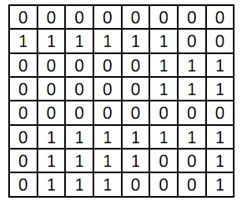Question: You are given a binary image consisting of only zeros and ones, see image. Apply required morphological operations and give the output images on the grid.

Question: Suggest an algorithm in order to find the local maxima points of a given gray-scale image. (Hint: Gray-scale morphology would be useful)
Question: Consider the filter h[n, m] describing the input-output relationship below:
g[n,m]=f[n-1,m]+ f[n,m-1]+ f[n+1,m]+ f[n,m+1]
a) What is the impulse response of this filter?
b) Derive its Fourier Transform and sketch its magnitude and phase spectrum.
c) What type of a filter is this? Justify your answer.
Question: Compute the Fourier Transform of the following function:
f(x) = exp(- x2/(2σ2)) cos (2πx/k)
Where σ and k are constants.
What is the minimum sampling rate required for alias-free reconstruction, if any?
Question: Assume that the model illustrated below is linear and position invariant. Also the noise and the image are uncorrelated.

Show that the power spectrum of the output is:
|G(u, v)2| = |H(u, v)|2 |F(u, v)|2 + |N(u, v)|2
Question: Discuss how Wavelet Transform is suitable for each application below. You can give examples if you need to.
a) Multi-resolution analysis of signals and images.
b) Space-frequency analysis.
c) Coding and compression.
e) Edge detection.
f) Object recognition.
Question: We have discussed three different color spaces: RGB, HSI and CMY(K). Specify the need for multiple color spaces. Why can we not use only one?
Question: A telescope in an observatory is used to produce images on a high-resolution CCD array. Assume the optics is flawed so that the images are blurry. Keeping in mind that only astronomical objects are viewed, describe two ways of correcting the blur.
Question: The magnitude spectrum of a continuous image is as given below.
a) Sketch the frequency response of the sampled spectrum if ωs =1.5 ωm along x and 3ωm along y directions in the figure below.
b) What is the minimum sampling rate along x and y to avoid aliasing?
c) Do you believe this is the most efficient sampling scheme? Why or why not? If you were to select a more efficient sampling scheme in what ways would it make the sampling more complicated?

Question: Given the following noisy image segment g(m, n):

Assume the noise is additive to and independent of the noiseless image f(m, n). The global image noise variance is 100. Calculate the adaptive Wiener filter output at pixels (2, 2) and (3, 3) using a 3x3 pixel neighborhood and uniform box filters. Discuss your findings.